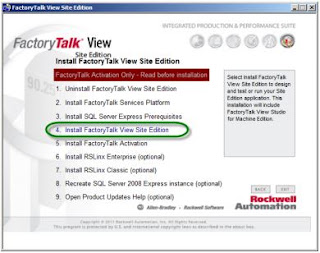Factorytalk SE 6.1 จะเป็นโปรแกรมที่รันบน OS 64 bit
ขั้นตอนการลงโปรแกรม Factorytalk SE V6.1
1. ต้องใช้ user ที่เป็น Administrator ของเครื่องที่จะลงโปรแกรม
2. ติดตั้ง Microsoft Internet Information (IIS) ใน Windows Features โดยจะทำการติดตั้ง
- IIS Metabase and IIS 6 configurationcompatibility
- ASP และ ISAPI Extension
- WebDAV Publishing ดังรูปตัวอย่าง Windows Server 2008 ด้านล่าง
- IIS Metabase and IIS 6 configurationcompatibility
- ASP และ ISAPI Extension
- WebDAV Publishing ดังรูปตัวอย่าง Windows Server 2008 ด้านล่าง
3. เปิด Program install และเลือก Install Factory Talk View Site Edition
4. Install Factorytalk Service Platform โดยเลือกติดตั้งแบบ Standard
หาก computer ยังไม่ได้ install Microsoft .NET Framework 3.5 SP1 มันจะ install ให้อัตโนมัติ
5. Install SQL Server Express
การตั้ง password ของ SQL โดยมีเงื่อนไขในการตั้งดังนี้
- ห้าม blank
- ห้ามใช้ชื่อ เหล่านี้ Password, Admin, Administrator, sa, sysadmin, username ที่ login อยู่, ชื่อเครื่อง computer ที่ติดตั้งอยู่
- ต้องมีความยาวอย่างน้อย 8 ตัวอักษรและมีตัวอักษรเล็ก ใหญ่ และตัวเลข
6. Install Factorytalk View Site Edition
- จะมี Message Box แจ้งเตือนว่า จะ stop Application ของ Rockwell ที่ Run อยู่ตอนนี้ เพื่อลง Program Factorytalk SE หากต้องการลง Program ต่อให้กด Yes
- Accept License ใส่ User name และ Product's Serial Number:0123456789
- เลือกการ Install แบบ Complete Type
- เลือก Drive ที่จะ install
- Install
- ระหว่าง install จะมี message box ถามว่าคุณได้ติดตั้ง IIS หรือยัง หากหากคุณได้ติดตั้งแล้วในหัวข้อที่ 2. ให้กด OK
- Set Factorytalk Directory Server Location เพื่อกำหนดชื่อ Computer ที่เก็บ HMI Project ซึ่งมี 2 mode คือ Local กับ Network ดังรูป
7. Install Factorytalk Activation เพื่อใช้ในการ Activate license แล้วเลือก Restart later
8. Install RSLinx Enterprise เพื่อใช้ในการติดต่อกับ PLC ของ Rockwell รุ่น Logic5000 เป็นต้นไป และยังสามารถสร้าง Database เพื่อเก็บ Alarm ต่างๆได้
8. Install RSLinx Enterprise เพื่อใช้ในการติดต่อกับ PLC ของ Rockwell รุ่น Logic5000 เป็นต้นไป และยังสามารถสร้าง Database เพื่อเก็บ Alarm ต่างๆได้
ในระหว่าง Install จะมี message box แจ้งเตือนจาก Windows ให้ เลือก Always trust ดังรูป
9. Install RSLinx Classic เพื่อใช้ในการติดต่อกับ PLC ของ Rockwell นอกเหนือจาก Logic5000 เป็นต้นไป หรือสามารถติดต่อกับ PLC ยี่ห้อได้โดยใช้ Protocal DH เป็น









